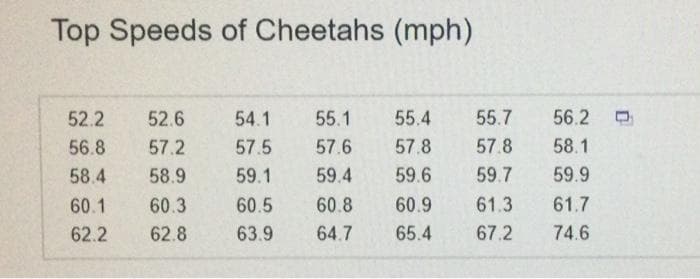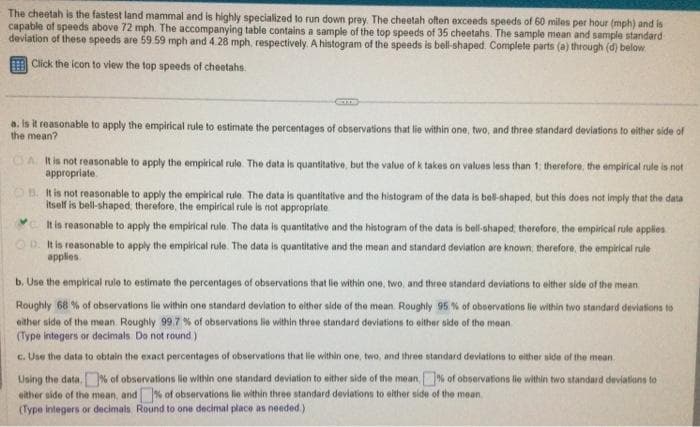The cheetah is the fastest land mammal and is highly specialized to run down prey. The cheetah often exceeds speeds of 60 miles per hour (mph) and is capable of speeds above 72 mph. The accompanying table contains a sample of the top speeds of 35 cheetahs. The sample mean and sample standard deviation of these speeds are 59.59 mph and 4.28 mph, respectively. A histogram of the speeds is bell-shaped. Complete parts (a) through (d) below. Click the icon to view the top speeds of cheetahs. a. Is it reasonable to apply the empirical rule to estimate the percentages of observations that lie within one, two, and three standard deviations to either side of the mean? A It is not reasonable to apply the empirical rule. The data is quantitative, but the value of k takes on values less than 1; therefore, the empirical rule is not appropriate O. It is not reasonable to apply the empirical rule. The data is quantitative and the histogram of the data is bell-shaped, but this does not imply that the data itself is bell-shaped, therefore, the empirical rule is not appropriate It is reasonable to apply the empirical rule. The data is quantitative and the histogram of the data is bell-shaped, therefore, the empirical rule applies D. It is reasonable to apply the empirical rule. The data is quantitative and the mean and standard deviation are known, therefore, the empirical rule applies b. Use the empirical rule to estimate the percentages of observations that lie within one, two, and three standard deviations to either side of the mean Roughly 68% of observations lie within one standard deviation to either side of the mean. Roughly 95 % of observations lie within two standard deviations to either side of the mean Roughly 99.7% of observations lie within three standard deviations to either side of the mean (Type integers or decimals. Do not round) c. Use the data to obtain the exact percentages of observations that lie within one, two, and three standard deviations to either side of the mean Using the data.% of observations lie within one standard deviation to either side of the mean % of observations lie within two standard deviations to either side of the mean, and % of observations lie within three standard deviations to either side of the mean (Type integers or decimals Round to one decimal place as needed.)
The cheetah is the fastest land mammal and is highly specialized to run down prey. The cheetah often exceeds speeds of 60 miles per hour (mph) and is capable of speeds above 72 mph. The accompanying table contains a sample of the top speeds of 35 cheetahs. The sample mean and sample standard deviation of these speeds are 59.59 mph and 4.28 mph, respectively. A histogram of the speeds is bell-shaped. Complete parts (a) through (d) below. Click the icon to view the top speeds of cheetahs. a. Is it reasonable to apply the empirical rule to estimate the percentages of observations that lie within one, two, and three standard deviations to either side of the mean? A It is not reasonable to apply the empirical rule. The data is quantitative, but the value of k takes on values less than 1; therefore, the empirical rule is not appropriate O. It is not reasonable to apply the empirical rule. The data is quantitative and the histogram of the data is bell-shaped, but this does not imply that the data itself is bell-shaped, therefore, the empirical rule is not appropriate It is reasonable to apply the empirical rule. The data is quantitative and the histogram of the data is bell-shaped, therefore, the empirical rule applies D. It is reasonable to apply the empirical rule. The data is quantitative and the mean and standard deviation are known, therefore, the empirical rule applies b. Use the empirical rule to estimate the percentages of observations that lie within one, two, and three standard deviations to either side of the mean Roughly 68% of observations lie within one standard deviation to either side of the mean. Roughly 95 % of observations lie within two standard deviations to either side of the mean Roughly 99.7% of observations lie within three standard deviations to either side of the mean (Type integers or decimals. Do not round) c. Use the data to obtain the exact percentages of observations that lie within one, two, and three standard deviations to either side of the mean Using the data.% of observations lie within one standard deviation to either side of the mean % of observations lie within two standard deviations to either side of the mean, and % of observations lie within three standard deviations to either side of the mean (Type integers or decimals Round to one decimal place as needed.)
Glencoe Algebra 1, Student Edition, 9780079039897, 0079039898, 2018
18th Edition
ISBN:9780079039897
Author:Carter
Publisher:Carter
Chapter10: Statistics
Section10.3: Measures Of Spread
Problem 1GP
Related questions
Question
how can i find the percentage of observations for the top speed of the cheetahs in part C

Transcribed Image Text:Top Speeds of Cheetahs (mph)
52.2 52.6
54.1
56.8 57.2
57.5
58.4 58.9 59.1
60.1 60.3 60.5
62.2
62.8
63.9
55.1 55.4 55.7 56.2
57.6
57.8
57.8
58.1
59.4 59.6 59.7 59.9
60.8
60.9 61.3
61.7
64.7
65.4
67.2
74.6

Transcribed Image Text:The cheetah is the fastest land mammal and is highly specialized to run down prey. The cheetah often exceeds speeds of 60 miles per hour (mph) and is
capable of speeds above 72 mph. The accompanying table contains a sample of the top speeds of 35 cheetahs. The sample mean and sample standard
deviation of these speeds are 59.59 mph and 4.28 mph, respectively. A histogram of the speeds is bell-shaped. Complete parts (a) through (d) below.
Click the icon to view the top speeds of cheetahs
a. Is it reasonable to apply the empirical rule to estimate the percentages of observations that lie within one, two, and three standard deviations to either side of
the mean?
It is not reasonable to apply the empirical rule. The data is quantitative, but the value of k takes on values less than 1; therefore, the empirical rule is not
appropriate
5. It is not reasonable to apply the empirical rule. The data is quantitative and the histogram of the data is bell-shaped, but this does not imply that the data
Itself is bell-shaped, therefore, the empirical rule is not appropriate
It is reasonable to apply the empirical rule. The data is quantitative and the histogram of the data is bell-shaped, therefore, the empirical rule applies
OD. It is reasonable to apply the empirical rule. The data is quantitative and the mean and standard deviation are known, therefore, the empirical rule
applies
b. Use the empirical rule to estimate the percentages of observations that lie within one, two, and three standard deviations to either side of the mean
Roughly 68% of observations lie within one standard deviation to either side of the mean. Roughly 95 % of observations lie within two standard deviations to
either side of the mean. Roughly 99.7% of observations lie within three standard deviations to either side of the mean
(Type integers or decimals. Do not round)
c. Use the data to obtain the exact percentages of observations that lie within one, two, and three standard deviations to either side of the mean
Using the data.% of observations lie within one standard deviation to either side of the mean % of observations lie within two standard deviations to
either side of the mean, and % of observations lie within three standard deviations to either side of the mean
(Type integers or decimals Round to one decimal place as needed.)
Expert Solution
This question has been solved!
Explore an expertly crafted, step-by-step solution for a thorough understanding of key concepts.
This is a popular solution!
Trending now
This is a popular solution!
Step by step
Solved in 3 steps with 6 images

Recommended textbooks for you

Glencoe Algebra 1, Student Edition, 9780079039897…
Algebra
ISBN:
9780079039897
Author:
Carter
Publisher:
McGraw Hill

Glencoe Algebra 1, Student Edition, 9780079039897…
Algebra
ISBN:
9780079039897
Author:
Carter
Publisher:
McGraw Hill